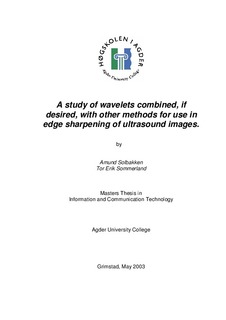| dc.contributor.author | Solbakken, Amund | |
| dc.contributor.author | Sommerland, Tor Erik | |
| dc.date.accessioned | 2007-07-10T08:25:59Z | |
| dc.date.issued | 2003 | |
| dc.identifier.uri | http://hdl.handle.net/11250/137280 | |
| dc.description | Masteroppgave i informasjons- og kommunikasjonsteknologi 2003 - Høgskolen i Agder, Grimstad | en |
| dc.description.abstract | The increased use of laparoscopic surgery has resulted in a growing interest in use of
ultrasounds. Ultrasounds do not have any known side effects, and it provides the
surgeon with real-time imaging. In spite of its advantages, ultrasounds also have
some disadvantages. The most obvious is that ultrasound images contain much noise.
Another problem is that edges of vital organs may appear diffuse. In this thesis we
will look at ways of sharpening edges by using a relatively new mathematical
method called wavelet.
With wavelets we analyse signals according to scale. This idea started with Fourier
in the 1800’s, when he used sines and cosines to represent functions. After Fourier,
mathematicians where led from frequency to scale analysis of functions. But it was
not until the 1980’s that wavelets really came in to play. The work done by Ingrid
Daubechies in 1990 was a milestone in the world of wavelets; she created a set of
orthonormal basis functions.
In this thesis our motive was to sharpen edges of blood vessels in ultrasound images.
These edges may be both dark and diffuse, and our goal was to make them narrower
and brighter. To find out if wavelets could be used for this purpose we developed a
prototype application that implements the wavelet-based methods. With this
application we performed some tests on very simple synthetic images containing
edges. Our results imply that the Mexican hat wavelet is exceptionally well suited for
finding and sharpening edges. We were able to “attune” the Mexican hat to the edge
so that the centre of the edge became many times brighter, at the same time as the
noise in the image was reduced. We were able to both located the two sides of the
edge so that it could be made narrower manually, in addition to make the edge
slimmer by means of wavelet transformation. | en |
| dc.format.extent | 899174 bytes | |
| dc.format.mimetype | application/pdf | |
| dc.language.iso | eng | en |
| dc.publisher | Høgskolen i Agder | |
| dc.publisher | Agder University College | |
| dc.subject.classification | IKT590 | |
| dc.title | A study of wavelets combined, if desired, with other methods for use in edge sharpening of ultrasound images | en |
| dc.type | Master thesis | en |
| dc.subject.nsi | VDP::Matematikk og naturvitenskap: 400::Informasjons- og kommunikasjonsvitenskap: 420::Algoritmer og beregnbarhetsteori: 422 | |
| dc.subject.nsi | VDP::Matematikk og naturvitenskap: 400::Informasjons- og kommunikasjonsvitenskap: 420::Simulering, visualisering, signalbehandling, bildeanalyse: 429 | |
